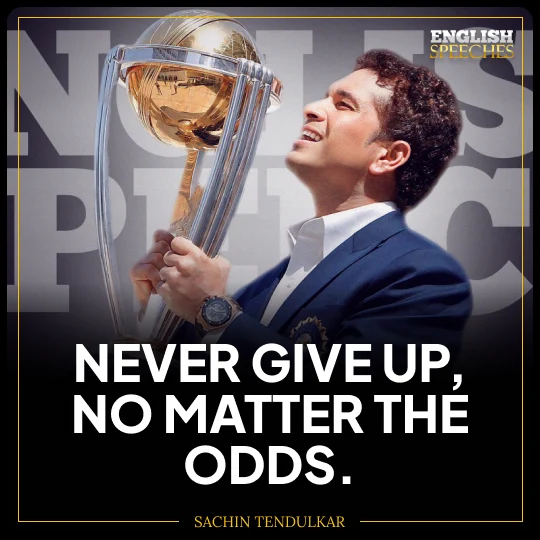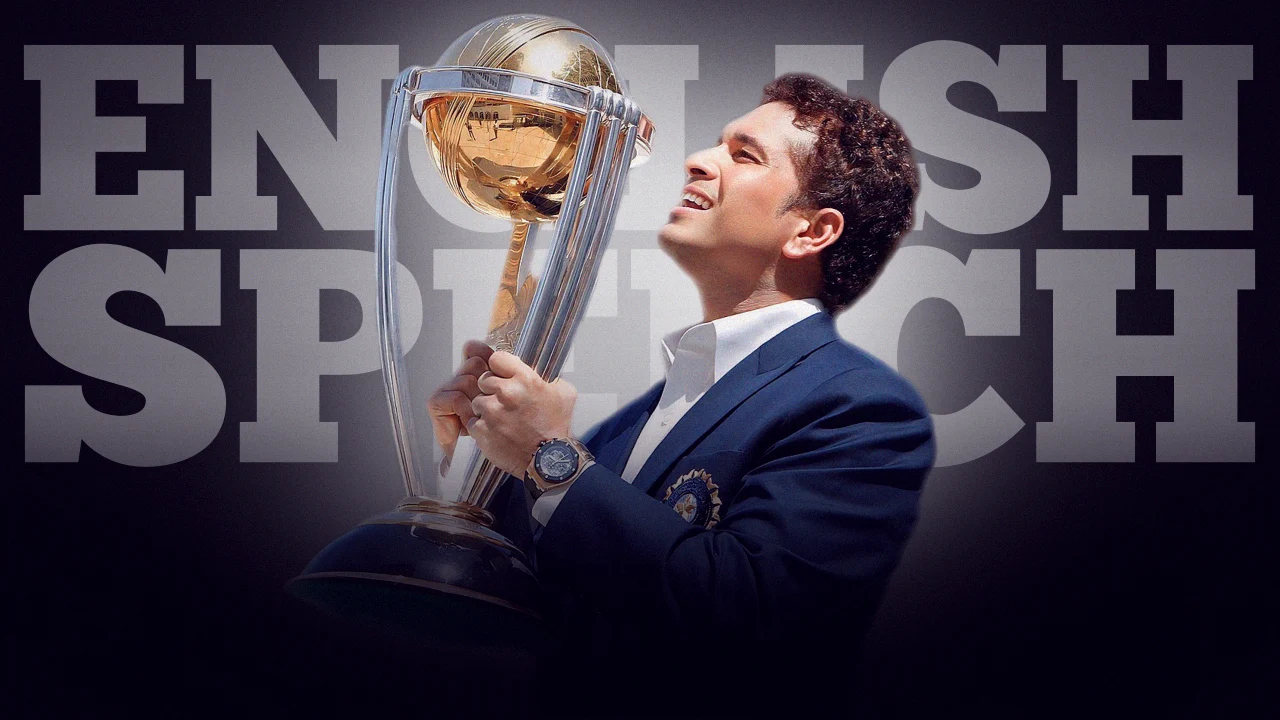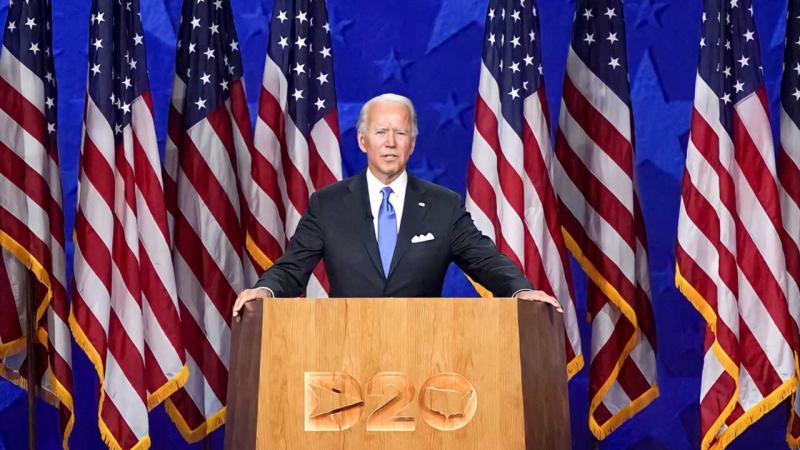Learn English with Sachin Tendulkar as he shares insights from his remarkable cricketing journey, including his early experiences, challenges, and unforgettable moments. In this interview, Tendulkar reflects on his career, his autobiography “Playing It My Way,” and how he became a cricketing legend. Discover the wisdom of one of the greatest cricketers of all time and learn valuable life lessons along the way.
Sachin Tendulkar, a cricketing icon whose career spanned over two decades, has inspired millions both on and off the field. In a recent interview, Tendulkar shared his journey, from his early days as a cricket-obsessed child in Mumbai to becoming the highest run-scorer in the history of the sport. He also delved into personal moments that shaped his life and career, providing a rare glimpse into the man behind the legend. This interview offers valuable insights into the discipline, dedication, and passion that drove Tendulkar to greatness and the lessons that can be drawn from his remarkable story.
A Journey of Passion and Dedication
During his interview, Sachin Tendulkar recounted the experiences that molded him into the cricketer he became. He shared an anecdote from his childhood when he practiced with a specially modified golf ball to hone his defensive technique. This story highlights three key aspects of Tendulkar’s journey:
- Early Dedication: Tendulkar’s commitment to cricket was evident even as a child. His innovative practice methods, such as using a golf ball to simulate challenging scenarios, laid the foundation for his future success.
- Adaptability and Skill: Throughout his career, Tendulkar adapted to various roles, from a fast bowler in his youth to mastering both spin and seam bowling in the nets, demonstrating his versatility and deep understanding of the game.
- Personal Resilience: Tendulkar’s ability to overcome criticism, injuries, and the immense pressure of leading the Indian cricket team reflects his unwavering resilience and mental strength.
Tendulkar emphasized how these experiences not only shaped his cricketing technique but also instilled in him the values of hard work and perseverance, which were crucial to his success.
Key Lessons and Themes
Sachin Tendulkar’s interview is rich with lessons and themes that resonate beyond the cricketing world:
- The Importance of Innovation: Tendulkar’s use of creative methods, like the modified golf ball practice, underscores the value of innovation in achieving excellence. Thinking outside the box can provide a competitive edge in any field.
- Balancing Personal and Professional Life: Despite his global fame, Tendulkar remained a private individual, devoted to his family. His ability to balance a demanding career with personal commitments offers a powerful lesson in maintaining equilibrium in life.
- Dealing with Adversity: Tendulkar’s career was not without its challenges, including criticism during his captaincy and injuries. His approach to handling adversity—by staying focused on his goals and not letting external pressures affect him—is a key takeaway for anyone facing tough situations.
- Legacy and Impact: Beyond his records, Tendulkar’s legacy is defined by his humility, sportsmanship, and the inspiration he provides to aspiring cricketers. His story is a testament to the impact one individual can have on a nation and the world.
As we reflect on Sachin Tendulkar’s journey, it is clear that his life offers valuable lessons in dedication, innovation, and resilience. His story continues to inspire not only cricket enthusiasts but also individuals striving for success in any arena. By embracing the values that Tendulkar exemplified, we can all aspire to achieve greatness in our own lives.
Donwload available for Premium Subscribers
PDF Full Transcript
Explore every word with our concise PDF transcripts.
Audio Version
Immerse in speeches with clear, downloadable audios.
English Lesson
Enhance English skills with interactive speech lessons.
⚬ Free 30-day trial

”Never give up, no matter the odds.
Transcript
A tennis player or a cricketer? Definitely a cricketer. No, no, tennis was good fun. I enjoyed playing tennis, I enjoyed watching tennis, but I was always in love with cricket, and cricket would always be my first love.
Talking about the golf ball significance in my life, in fact, it was in the early part of my life when I was only 11 years old and staying with my aunt. I would make her chuck a number of balls a day. The golf ball, I had purposely taken a blade and made that into an oval shape so that it would hit the floor and then change direction. It sort of taught me to play back foot defense with soft hands. Also, not being so tall, throughout my career, I had to be on my toes, and I thought somewhere that golf ball practice had a role to play in my technique. And basically, as an 11-year-old, full of energy, and in spite of practicing for a number of hours on the field, I still had to do something related to cricket. That’s how I killed my time.
My interest in bowling was always there. In fact, as a youngster, I think I was only 12 or 13 years old, I went to Chennai for Dennis Lillee’s fast bowling MRF camp, where he suggested that I stick to batting, because not knowing that I was actually a batsman wanting to learn how to bowl fast because fast bowling was something that always fascinated me. Sometimes, being a school captain helped because, with the new ball, I could bowl seam ups. Then, with the semi-new ball, I would bowl off-spin, and with the old ball, I’d bowl leg spin. By then, the second new ball would be available. So I continued bowling, and that continued even in the nets. When I played for India for almost the first 20-22 years of my career, I bowled to all 10-12 batsmen in the nets. I would bowl seam ups if the wicket was helpful for fast bowlers, and bowl leg spin, off-spin. Basically, it was just playing more cricket, grasping more things in life, getting to know more about cricket, and gathering more information from various players.
The first time I met Anjali at my place, Anjali had turned up as a journalist because I didn’t know how to invite her otherwise. She said, “I’m close to your house, can I meet you?” Until then, no girl had visited my house, and this was the first time. I didn’t know how to deal with that. So I said, “You have to walk in as a journalist wanting to interview me; otherwise, you have no other chance of coming here.” So she pretended to be a journalist when she came to my house for the first time. I had to offer her something, so I offered her chocolate. In fact, I only had one chocolate, which was the case because of me and my family polishing off all the chocolates, mainly my brothers, and only one chocolate was left. So I cut that chocolate into small pieces and spread them all over the plate, thinking that it would look like there were many chocolates put together. I precisely remember that meeting was something special, and then I think my family realized that she wasn’t a journalist. The body language said it all.
When Sara was born, I was at Anjali’s house, which is like 50 meters away from the hospital. I was with a very, very dear friend of mine, my childhood friend Sunil Harsha, and we were on the terrace of Anjali’s house. I said, “I cannot believe that, you know, in hours from now, I’ll become a father, and life is going to change.” So we both were sort of restless and looking forward to what was going to happen in my life. As soon as I got a phone call, I rushed to the hospital, and I was there. That first glimpse of Sara was special. I can never forget it.
I thought the first phase was a difficult one, and there were differences in our opinions. I felt the selectors were thinking something different, and I was thinking something different. I wasn’t given the team that I wanted. There were a few individuals that I wanted in the team, which didn’t happen, and which was a big setback and a big disappointment because my only goal was to win matches for India, and I didn’t want anything else. I felt we were not on the same wavelength. We were thinking differently, and if a captain has to go out in the middle and take his team and want them to play the way I want to play cricket, then he’s got to have the players that I want, which didn’t happen. So that was the first phase of my captaincy.
The second one was also a challenging one. We went to some tough places. We went to Australia, and we went to South Africa as well, and things were not happening according to the way I wanted. All in all, I felt that we were not putting enough runs on the board. I don’t think we scored 300 even once in three test matches in Australia. Six innings, if you don’t score 300 even once, then you are not likely to win, but lose that test. In fact, even ending up in a draw would have been a great result because Australia, being the top side in the world, we would have been happy with that, but that didn’t happen, more so because there were not enough runs on the board.
2011 World Cup… it doesn’t get any bigger than that in cricket. The whole country was celebrating, and needless to say, the dressing room was flowing with champagne and photographs being taken with each and every individual with that beautiful trophy. That’s when I had called Anjali. Anjali saw the match on television because she is superstitious and then rushed to the stadium only to realize that, on all the car, on top of the roof, guys were jumping and dancing and celebrating our victory. The moment they recognized her, they said, “Not this car; let’s jump on the other one,” and Anjali walked into the dressing room. The same car went out, and they said, “Now we can jump on this car, she’s not there.” So those dents were special ones, I mean dents that I am proud of… a fantastic experience. After that, with all that happening in the dressing room, we went back to the hotel. All the room doors were open with loud music and friends there on the floor. In our room, I remember only the two of us were there, Anjali and I, and the door was open. We found flowers there, so we both put flowers in our ears, and we started celebrating with a champagne glass and loud music, and we danced. Which I have never done in my life. That’s the only time that I have celebrated any victory that much, and the celebrations continued till the morning hours. It was a fantastic experience, it will stay with me for the rest of my life.
My vision was, on my 40th birthday, we introduced Spreading Happiness India Foundation, where we decided to light up the villages where there is no electricity, and post-sunset, there is darkness in their lives. To imagine something like that exists in our nation is a little difficult to digest, and that’s when we decided that this foundation is going to help light up the entire nation. It’s all about spreading happiness, and that’s why we call this initiative, our foundation, Spreading Happiness India Foundation. India, because India and Diya are inside your house, so India. It’s all about giving a fair platform to disadvantaged communities, and if we can allow the future of India to study at night, to read books, the backbone of any family, the mother, to cook food in proper light and not in darkness, it’s surely going to change our nation. It’s going to change slowly but surely, and that is what we are looking at. So I will continue to give 100% and make all the possible efforts in lighting up the whole nation.
Along with this, the second vertical I am focusing on in my second innings is supporting an NGO called Apnalaya. I have been associated with them for the last 20 years now, but after my retirement, I am going to be involved even more in raising funds for them. It’s all about women empowerment, giving them a fair opportunity, allowing them to realize their dreams, and I think it’s so important for every girl child to dream that she can become somebody big in life and bring laurels to our nation. My second innings is more about satisfaction, the first one was more about excitement, pride, and playing for the nation, wearing that beautiful India cap. The second innings is all about satisfaction, giving to the people who have supported me, who have helped me for a number of years now.






